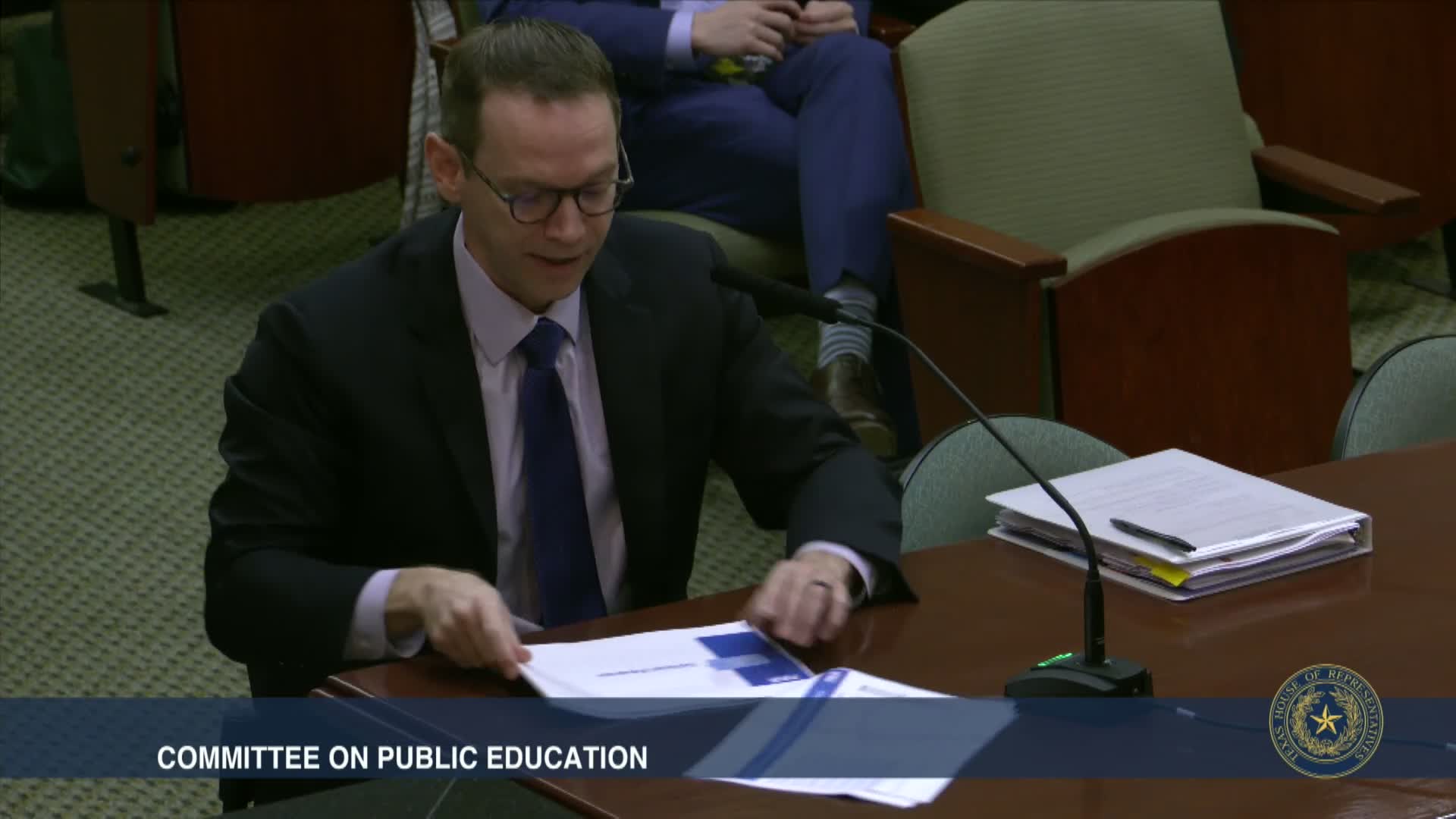TEA: federal COVID funding receding, local districts face enrollment shifts and deficit budgets
February 25, 2025 | Committee on Public Education, HOUSE OF REPRESENTATIVES, Legislative, Texas
This article was created by AI summarizing key points discussed. AI makes mistakes, so for full details and context, please refer to the video of the full meeting. Please report any errors so we can fix them. Report an error »

At the House Committee on Public Education meeting on March 1, Texas Education Agency Commissioner Mike Morath told members that statewide school funding faces multiple pressures: the end of one‑time federal COVID funds, local enrollment changes and the mechanics of the school finance system.
Morath summarized the finance picture: statewide per‑pupil all‑in funding can be hard to aggregate because of federal infusion and local property tax variation, but the agency’s slide presented an all‑in per‑pupil figure in the mid‑$15,000 range as a frame of reference. He warned that one‑time federal resources that boosted district budgets in 2020–22 have largely been exhausted and that Texas school systems face a reduction in federal funding in the current year.
Why it matters
Committee members expressed concern about districts adopting deficit budgets, local bond and recapture pressures, and teacher pay after adjusting for inflation. Morath said districts that over‑hired during growth years now face painful adjustments when enrollment flattens or falls.
Key details
- ESSER drop: Morath said the “big increase in the size of that green bar between the 21 and 22 school years” was a one‑time federal infusion tied to COVID and that that resource has largely dried up.
- Per‑pupil and inflation: Morath said average teacher pay rose about 15% in the last five years while inflation rose roughly 24%, meaning real pay has declined. Committee members asked the agency to provide inflation‑adjusted teacher pay numbers benchmarked to 2019.
- Enrollment shifts and district posture: Morath explained districts operate in different demographic environments (growing, flat, declining). Rapidly growing districts historically over‑hired to prepare for fall enrollment, a budgeting posture that can produce deficits if enrollment drops. Several members cited recent local examples of district classroom reductions and school closures.
- Recapture and tax compression: Members and the commissioner discussed property‑wealth recapture and the ways state tax policy and entitlement formulas affect local budgets. Morath said data for the most recent school year — reflecting the last session’s property tax compression — would be available after PEIMS and finance reporting closes and could materially change the visual breakdown between state and local contributions.
Lawmakers’ concerns and requests
Members across urban, suburban and coastal districts described high local impacts: closures, large insurance costs in coastal districts, and structural recapture pressure. Lawmakers asked for updated finance charts that incorporate the most recent tax compression and asked the agency for district‑level budget status and recent fund‑balance trends. Morath said some deficits are traceable to districts’ use of ESSER funds for recurring expenditures and confirmed the agency can provide more granular budget and fund‑balance reporting.
Ending
Committee members signaled the issue will be central in budget and school finance deliberations this session. They asked TEA to produce updated, inflation‑adjusted analyses of teacher pay, district deficits, fund balances and the impact of federal funding phase‑out.
Morath summarized the finance picture: statewide per‑pupil all‑in funding can be hard to aggregate because of federal infusion and local property tax variation, but the agency’s slide presented an all‑in per‑pupil figure in the mid‑$15,000 range as a frame of reference. He warned that one‑time federal resources that boosted district budgets in 2020–22 have largely been exhausted and that Texas school systems face a reduction in federal funding in the current year.
Why it matters
Committee members expressed concern about districts adopting deficit budgets, local bond and recapture pressures, and teacher pay after adjusting for inflation. Morath said districts that over‑hired during growth years now face painful adjustments when enrollment flattens or falls.
Key details
- ESSER drop: Morath said the “big increase in the size of that green bar between the 21 and 22 school years” was a one‑time federal infusion tied to COVID and that that resource has largely dried up.
- Per‑pupil and inflation: Morath said average teacher pay rose about 15% in the last five years while inflation rose roughly 24%, meaning real pay has declined. Committee members asked the agency to provide inflation‑adjusted teacher pay numbers benchmarked to 2019.
- Enrollment shifts and district posture: Morath explained districts operate in different demographic environments (growing, flat, declining). Rapidly growing districts historically over‑hired to prepare for fall enrollment, a budgeting posture that can produce deficits if enrollment drops. Several members cited recent local examples of district classroom reductions and school closures.
- Recapture and tax compression: Members and the commissioner discussed property‑wealth recapture and the ways state tax policy and entitlement formulas affect local budgets. Morath said data for the most recent school year — reflecting the last session’s property tax compression — would be available after PEIMS and finance reporting closes and could materially change the visual breakdown between state and local contributions.
Lawmakers’ concerns and requests
Members across urban, suburban and coastal districts described high local impacts: closures, large insurance costs in coastal districts, and structural recapture pressure. Lawmakers asked for updated finance charts that incorporate the most recent tax compression and asked the agency for district‑level budget status and recent fund‑balance trends. Morath said some deficits are traceable to districts’ use of ESSER funds for recurring expenditures and confirmed the agency can provide more granular budget and fund‑balance reporting.
Ending
Committee members signaled the issue will be central in budget and school finance deliberations this session. They asked TEA to produce updated, inflation‑adjusted analyses of teacher pay, district deficits, fund balances and the impact of federal funding phase‑out.
View full meeting
This article is based on a recent meeting—watch the full video and explore the complete transcript for deeper insights into the discussion.
View full meeting
